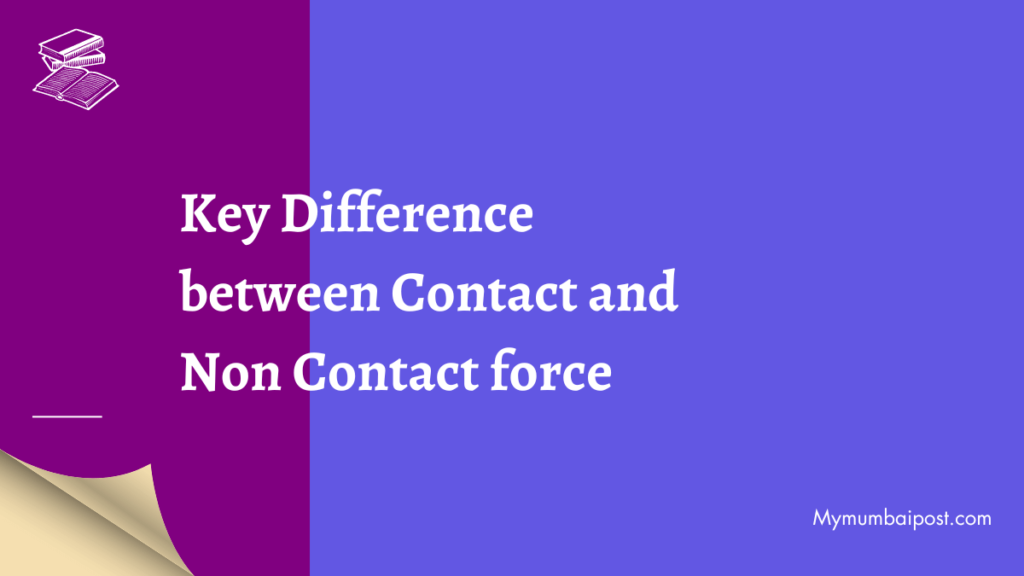
Explore 15 Key Difference between Contact and Non Contact force
In the realm of physics, forces govern the interactions between objects, shaping our physical world. Two fundamental categories of forces, contact and non-contact, offer intriguing contrasts. In this exploration, we embark on an illuminating journey to uncover the 15 key difference between contact and non contact force, unraveling the intricacies of our universe.
Difference between Contact and Non Contact force
Physical Interaction: Physical interaction is the main point of distinction. Non-contact forces act over distances without direct touch, defying our innate belief that touch is the only form of interaction, whereas contact forces demand direct contact between objects.
Contact forces are transmitted by a mediating medium, such as solids, liquids, or gases, which serve as channels for the movement of energy. Instead of requiring a medium to exert their power, non-contact forces like gravity and magnetism can do so through void space.
Contact forces are localised and only affect the objects that are closest to the point of contact. On the other hand, non-contact forces have a wide range of influence, are able to act over very large distances, and can interact with numerous objects at once.
Contact forces frequently produce tangible sensations, enabling us to feel their effects firsthand. We can better understand the forces acting on our bodies thanks to our sense of touch. Contrarily, non-contact forces are invisible and frequently need to be observed and measured in order to be recognised as being present and having an impact on objects.
Repulsive and Attractive: Contact forces only ever take the form of attractive forces, bringing things together. Non-contact forces, however, show both attractive and repellent tendencies. For instance, the dual nature of non-contact forces is illustrated by the attraction of masses by gravity and the mutual repulsion of magnetic poles.
Transmission Methods: Contact forces use impact, compression, and tension to transmit energy through direct physical contact. Non-contact forces can exert their effects over very long distances by using a variety of transmission mechanisms, such as electromagnetic fields, gravitational fields, or radiation.
Complexity of Interaction: Contact forces frequently involve complex interactions, influenced by elements like the characteristics of the materials used, the state of the surfaces, and the shapes of the objects involved. However, non-contact forces only interact with objects based on their inherent characteristics, regardless of the state of the surface or other external factors.
Independence from Surface Area: The surface area of contact between two objects directly relates to the contact forces. In contrast, non-contact forces, such as gravity or magnetic forces, operate on an object’s entire mass or charge, regardless of its size or shape, regardless of its surface area.
Existence of the Normal Force: The presence of a normal force, which acts perpendicular to the contact surface and balances the applied external force, is required in the presence of contact forces. Non-contact forces act without direct contact, allowing for influences on objects in free space, and as such, by their very nature, do not need a normal force to exist.
Scale of Interactions: Interactions between common objects take place at macroscopic scales, where contact forces frequently manifest. The behaviour of particles, atoms, and celestial bodies is governed by non-contact forces, which operate at microscopic scales and reveal the mysteries of the cosmos.
Mobility Restrictions: Contact forces are constrained by the physical limitations and object mobility. Contrarily, non-contact forces do not abide by these limitations. For instance, gravity, which has no regard for physical boundaries, controls the motion of celestial bodies over great distances.
Contact forces are vulnerable to the presence of intervening obstacles that slow or prevent the transfer of force. Non-contact forces, on the other hand, can pass through barriers like gases, liquids, or even vacuum and continue to exert their influence unhindered, demonstrating their capacity to act across boundaries.
Role of Intuition: Contact forces work in concert with our natural sense of touch to help us understand how interactions work. Non-contact forces present a challenge to our intuitive understanding due to their unfamiliarity, necessitating scientific measurement, observation, and mathematical modelling to understand their complex mechanisms.
Reversible and Irreversible: Contact forces frequently involve reversible interactions, in which the effects may be cancelled out or reversed by an opposing force of equal and opposite magnitude. The gravitational pull of a large celestial body is an example of an irreversible interaction between non-contact forces that cannot be easily reversed or countered by opposing forces.
Limitations on Manipulation: Because our physical interactions change how objects behave, contact forces allow for direct manipulation and control of objects. Since non-contact forces are more ethereal, they restrict our ability to directly manipulate objects. Instead, we must use deceptive techniques to exert control, like using electromagnetic fields or gravitational forces.
In this exploration of the fascinating dichotomy between contact and non-contact forces, we have unraveled 15 distinctive characteristics that separate these forces. While contact forces operate through touch and physical proximity, non-contact forces transcend boundaries, acting over vast distances, and offering insight into the profound mysteries of our universe.
Also Read: Explore 15 Difference between Adolescence and Puberty